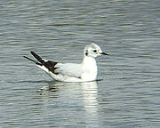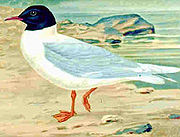
Little Gull
Encyclopedia
The Little Gull, Hydrocoloeus minutus or Larus minutus, is a small gull
which breeds in northern Europe
and Asia
. It also has small colonies in parts of southern Canada
. It is migratory
, wintering on coasts in western Europe, the Mediterranean and (in small numbers) the northeast USA. As is the case with many gulls, it has traditionally been placed in the genus
Larus
. It is the only member of the genus Hydrocoloeus, although it has been suggested that Ross's Gull
also should be included in this genus.
 This species breeds colonially on freshwater marshes, making a lined nest on the ground amongst vegetation. Normally, 2-6 eggs are laid.
This species breeds colonially on freshwater marshes, making a lined nest on the ground amongst vegetation. Normally, 2-6 eggs are laid.
This is the smallest gull species, with a length of 25 –, a wingspan of 61 – and a weight of 68–162 g (2.4–5.7 oz). It is pale grey in breeding plumage with a black hood, dark underwings and often a pinkish flush on the breast. In winter, the head goes white apart from a darker cap and eye-spot. The bill is thin and black and the legs dark red. The flight on rounded wings is somewhat tern-like
.
Young birds have black markings on the head and upperparts, and "W" pattern across the wings. They take three years to reach maturity.
These gulls pick food off the water surface, and will also catch insects in the air like a Black Tern
.
Gull
Gulls are birds in the family Laridae. They are most closely related to the terns and only distantly related to auks, skimmers, and more distantly to the waders...
which breeds in northern Europe
Europe
Europe is, by convention, one of the world's seven continents. Comprising the westernmost peninsula of Eurasia, Europe is generally 'divided' from Asia to its east by the watershed divides of the Ural and Caucasus Mountains, the Ural River, the Caspian and Black Seas, and the waterways connecting...
and Asia
Asia
Asia is the world's largest and most populous continent, located primarily in the eastern and northern hemispheres. It covers 8.7% of the Earth's total surface area and with approximately 3.879 billion people, it hosts 60% of the world's current human population...
. It also has small colonies in parts of southern Canada
Canada
Canada is a North American country consisting of ten provinces and three territories. Located in the northern part of the continent, it extends from the Atlantic Ocean in the east to the Pacific Ocean in the west, and northward into the Arctic Ocean...
. It is migratory
Bird migration
Bird migration is the regular seasonal journey undertaken by many species of birds. Bird movements include those made in response to changes in food availability, habitat or weather. Sometimes, journeys are not termed "true migration" because they are irregular or in only one direction...
, wintering on coasts in western Europe, the Mediterranean and (in small numbers) the northeast USA. As is the case with many gulls, it has traditionally been placed in the genus
Genus
In biology, a genus is a low-level taxonomic rank used in the biological classification of living and fossil organisms, which is an example of definition by genus and differentia...
Larus
Larus
Larus is a large genus of gulls with worldwide distribution . Many of its species are abundant and well-known birds in their ranges...
. It is the only member of the genus Hydrocoloeus, although it has been suggested that Ross's Gull
Ross's Gull
The Ross's Gull is a small gull, the only species in its genus, although it has been suggested it should be moved to the genus Hydrocoloeus, which otherwise only includes the Little Gull....
also should be included in this genus.

This is the smallest gull species, with a length of 25 –, a wingspan of 61 – and a weight of 68–162 g (2.4–5.7 oz). It is pale grey in breeding plumage with a black hood, dark underwings and often a pinkish flush on the breast. In winter, the head goes white apart from a darker cap and eye-spot. The bill is thin and black and the legs dark red. The flight on rounded wings is somewhat tern-like
Tern
Terns are seabirds in the family Sternidae, previously considered a subfamily of the gull family Laridae . They form a lineage with the gulls and skimmers which in turn is related to skuas and auks...
.
Young birds have black markings on the head and upperparts, and "W" pattern across the wings. They take three years to reach maturity.
These gulls pick food off the water surface, and will also catch insects in the air like a Black Tern
Black Tern
The Black Tern, Chlidonias niger, is a small tern generally found in or near inland water in Europe and North America. As its name suggests, it has predominantly dark plumage.- Description :...
.

